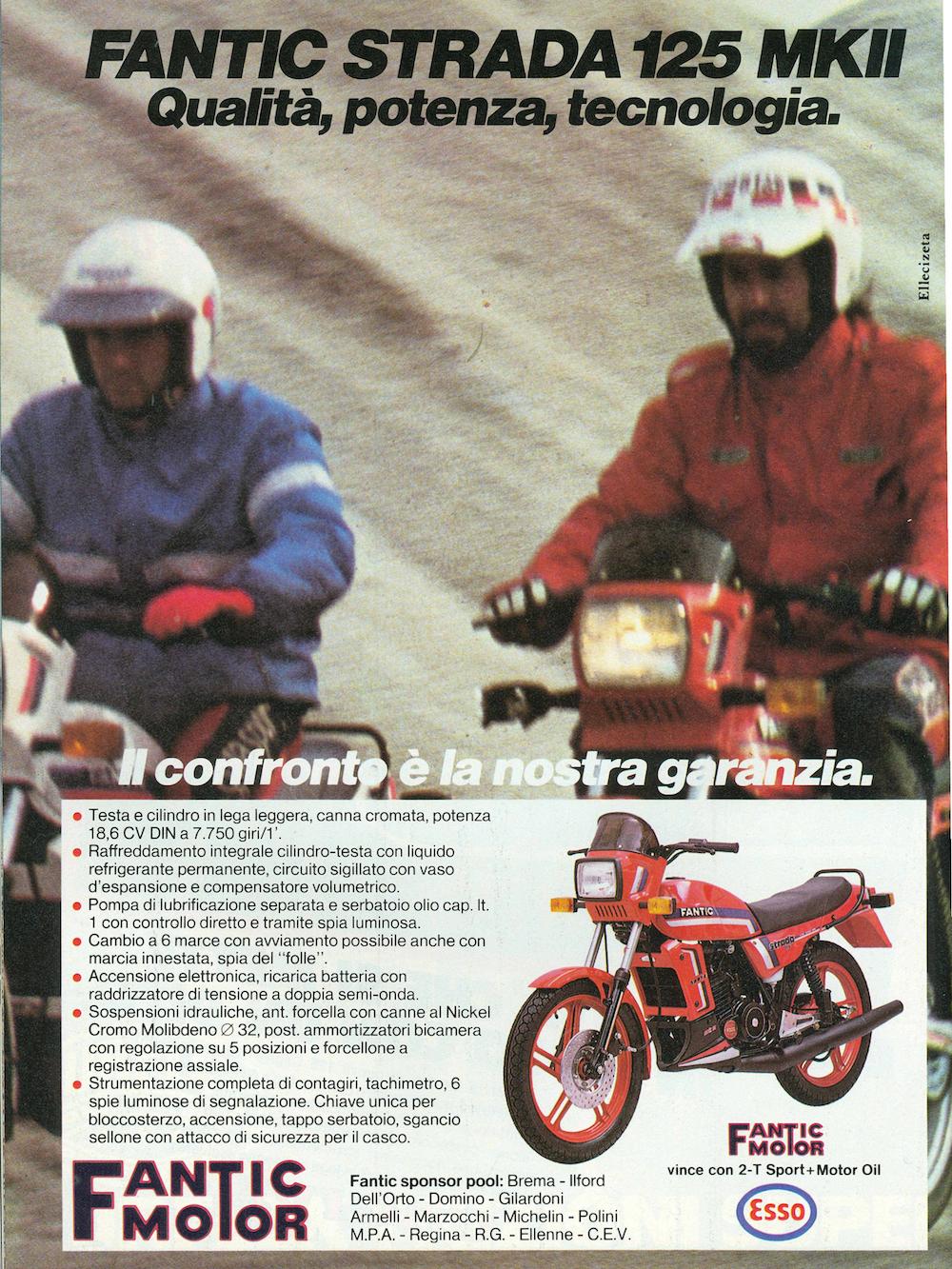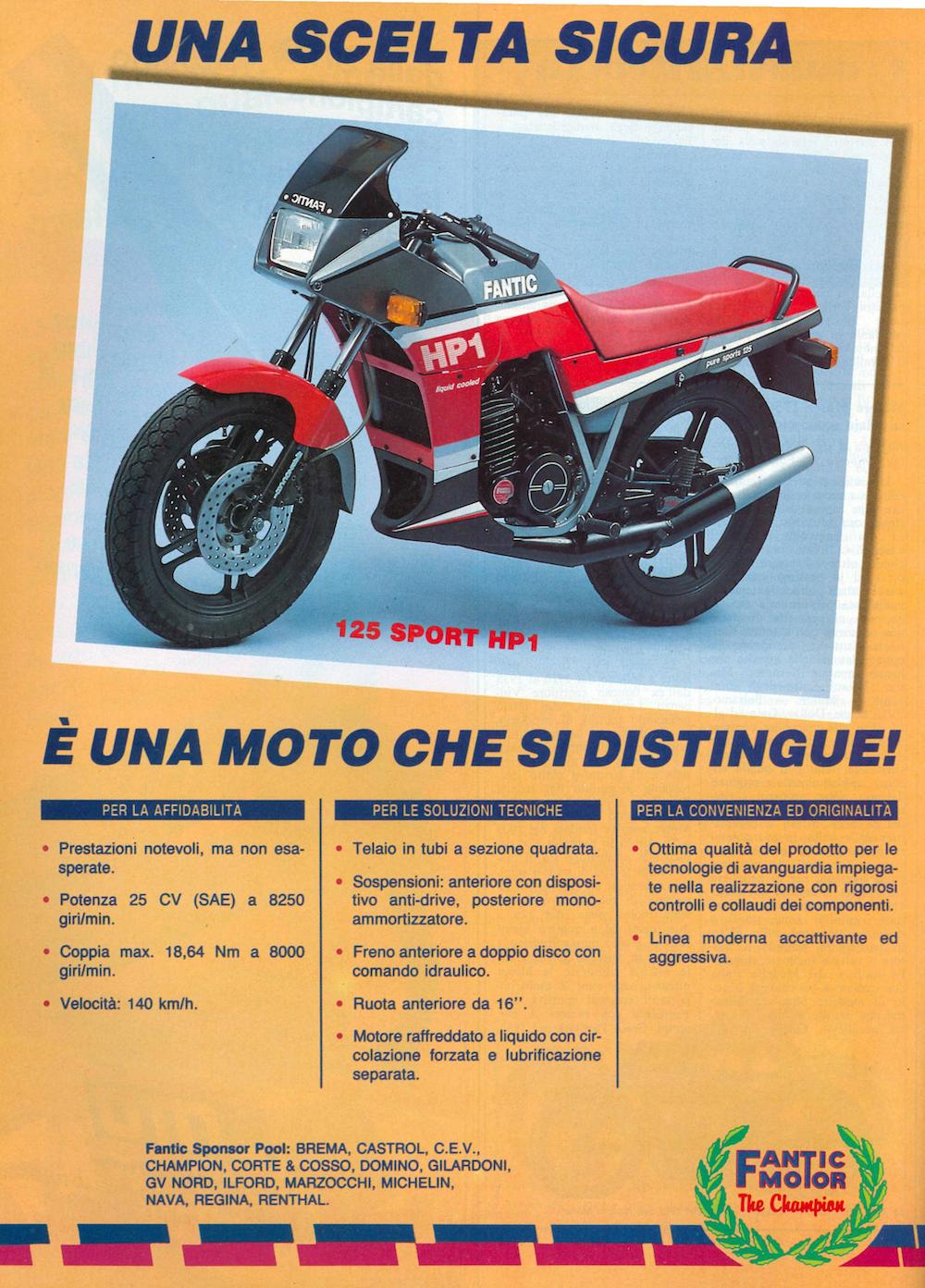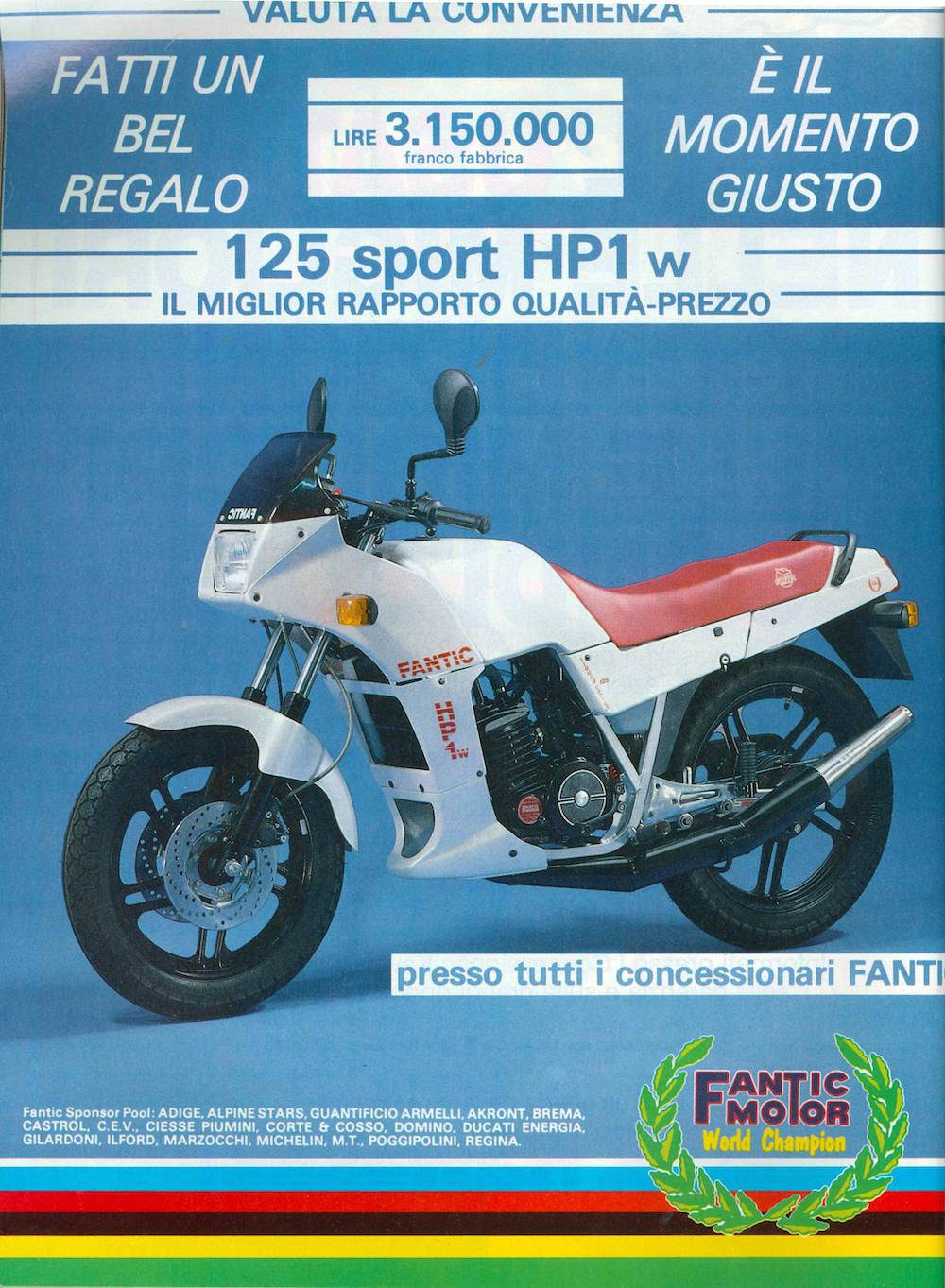Barzago, provincia di Como. Una cittadina che chi ama le ruote tassellate conosce molto bene. Da li hanno visto la luce le mitiche Fantic Caballero che tanti cuori hanno fatto battere, soprattutto negli anni 70. Fantic non ha mai dedicato troppe energie ai modelli stradali, ma quando all’inzio degli anni 80, la moda tra i 16 enni comincia a privilegiare le stradali alle enduro professionali, la casa di Barzago entra nel mercato delle 125 stradali con il modello Strada. Semplice e robusta, la Strada nasce raffreddata ad aria. Nel 1982 viene presentata la Strada Sport che le se differenzia per il raffreddamento a liquido. Segue la HP1 del 1985 che però viene presentata troppo in ritardo rispetto alla concorrenza che ormai le è anni luce avanti. Si chiude quindi il sipario per la gloriosa Fantic che riprenderà la produzione anni dopo sotto nuova proprietà e gestione. 125stradali.com si occupa solo delle 125 anni 80 e 90 raffreddate a liquido e quindi per ora non ci soffermeremo più di tanto sulla Strada raffreddata ad aria.
Ecco i modelli prodotti:
125 STRADA SPORT – 1983 – tipo FM 400A
Presentata al Motor Show del Dicembre 1982, Strada 125 Sport è la versione raffreddata a liquido della già conosciuta 125 Strada raffreddata ad aria e già proposta dalla Fantic.
Rispetto alla sorella raffreddata ad aria, la Sport vanta oltre al raffreddamento a liquido (con circolazione a termosifone) solamente un impianto di miscelazione separato ed un rapporto finale allungato. Non si tratta quindi di una moto inedita.
Nel 1982 e 1983 il top del mercato delle 125 stradali raffreddate a liquido sono le artigianali Malanca a due cilindri e la costosa Zundapp Ks che per via del suo prezzo elevato associato alla tipica qualità teutonica diviene un cult. Non a caso diviene la moto dei primi Paninari. La Laverda Lz, che monta lo stesso motore ed una ciclistica molto simile alla Zundapp Ks, diviene la 125 stradale raffreddata a liquido più venduta, grazie anche all’ottimo rapporto qualità-prezzo ed alla linea piacevole. Tra le 125 stradali, però la palma di 125 stradale più evoluta spetta alla Aprilia St 125, una moto che rispetto a tutte le altre vanta primizie assolute come, tra le altre, un motore raffreddato a liquido con pompa di circolazione, ammissione lamellare e mono ammortizzatore posteriore. In un tale contesto, la Fantic Strada Sport diviene una 125 di seconda scelta al pari della Garelli Tsr.
La Strada Sport viene proposta in vendita al prezzo di Lire 2.456.000 nelle colorazioni rosso o bianco. (La sorella raffreddata ad aria costa Lire 2.210.140).
La moto in breve
La Fantic ha una linea simile alle 125 stradali presentate in quel periodo, la cui caratteristica sembra essere il cupolino che carena faro anteriore e strumentazione, entrambi di dimensioni piuttosto importanti. La Sport vanta una presenza più sportiva per la presenza del copri radiatore verniciato in tinta con la carrozzeria. Sella e fianchetti vanno anche loro ad integrarsi molto bene con il serbatoio che è in lamiera.
Sotto alla sella, protetta da serratura, trovano posto il bocchettone per il serbatoio dell’olio del miscelatore, il filtro aria, la batteria, la centralina e un piccolo vano per gli attrezzi. Il vaso di espansione per l’impianto di raffreddamento trova posto sotto alla sella. L’impianto di scarico si trova sul lato sinistro con la catena di trasmissione su quello opposto: una particolarità comune alle Aprilia dotate del motore Rotax.
Curiosa è la presenza delle alette di raffreddamento sul cilindro quasi a non voler sottolineare la presenza del raffreddamento a liquido.
La strumentazione è una CEV ben disegnata e dotata di numerose spie: si tratta forse della strumentazione più completa e bella a vedersi rispetto a quelle di molte altre 125 stradali dell’epoca. I comandi al manubrio sono sempre CEV, ma datati nel disegno. Bene i mezzi manubri, la piastra di sterzo e l’antifurto a colonna integrato nel blocchetto di avviamento.
Ciclistica
Il telaio è un doppia culla continua in tubi di acciaio. All’anteriore viene adottata una forcella da 32 mm di produzione Fantic ed al posteriore un forcellone in acciaio abbinato a due ammortizzatori idraulici.
L’impianto frenante è misto disco/tamburo e vede all’anteriore un disco fisso Grimeca da 260 mm servito da pinza mono pistoncino ed al posteriore un tamburo da 160 mm.
Le ruote in lega leggera sono entrambi da 18”.
Motore
Il propulsore della Strada Sport è identico a quello montato sulla versione raffreddata ad aria. Le differenze riguardano ovviamente il gruppo termico e la presenza del radiatore che fa parte dell’impianto di raffreddamento del tipo a termosifone, cioè privo di pompa di raffreddamento.
Il carburatore Dell’Orto PHBL 25 BS rimane lo stesso della versione raffreddata ad aria, ma è predisposto per il miscelatore automatico (che ha solo la Sport) ed ha una carburazione differente.
Per entrambe le versioni il cambio è a 6 velocità, ma la Sport ha un rapporto finale più lungo complice l’erogazione del suo propulsore raffreddato ad acqua che migliora le doti di allungo del motore Fantic. Il propulsore raffreddato ad aria si mostra, invece, con più coppia ai bassi e medi regimi, ma cede in allungo. Motivo per cui la versione raffreddata ad aria ha un rapporto finale più corto.
La potenza massima rilevata alla ruota per la Sport è di 16,85 cv a 7900 giri (16,41 cv a 7700 giri la Strada) e la velocità massima rilevata è di 126,448 km/h. (120,110 km/h la Strada).
HP1 125 – 1985
Presentata nell’Autunno del 1984, la Fantic HP1, dove HP significa High Power, a causa di difficoltà finanziarie viene commercializzata solo a partire dal Luglio 1985.
L’erede della Strada 125 presentata nel 1981 è anche l’ultima 125 stradale prodotta dalla gloriosa casa di Barzago che dopo varie vicissitudini concentra la produzione solo sulle enduro fino alla chiusura dello storico stabilimento di Barzago nel 1995.
Il prezzo nel 1985 è di Lire 3.737.390 ed i colori disponibili sono Grigio/Bianco/Rosso e Bianco.
Come per le Garelli GTA, Laverda LB e GS Lesmo, la Fantic HP1 viene presentata in un mercato che vedeva ogni anno l’uscita di un modello inedito che invecchiava precocemente quelli precedenti tanto da renderli immediatamente obsoleti. In un mercato dove il successo commerciale viene prima di tutto decretato dai dati tecnici pubblicati dalle riviste dell’epoca, la HP1 si presenta quindi come una moto dalla linea superata e priva di quelle tecnologie come valvola allo scarico, contralbero di equilibratura e avviamento elettrico oramai giudicate indispensabili dai sedicenni dell’epoca.
Un vero peccato che Fantic non sia riuscita a presentare una moto in grado di capitalizzare sul suo marchio che era ancora uno dei più amati dai giovani.
La HP1 è l’ultima 125 stradale prodotta dalla Fantic.
La moto in breve
Come per altre 125 stradali presentate in quel periodo, la HP1 ha una linea piuttosto convenzionale. Il cupolino si accorda bene con il serbatoio, il copri radiatore ed il puntale formano un insieme piuttosto aggressivo e particolarmente ben accentuato dalla bella colorazione. Sella e fianchetti vanno anche loro ad integrarsi molto bene con il serbatoio che è in lamiera e molto ben fatto risulta il gruppo ottico posteriore.
Sotto alla sella, protetta da serratura, trovano posto il bocchettone per il serbatoio dell’olio del miscelatore, il filtro aria, la batteria, la centralina e un piccolo vano per gli attrezzi. Il vaso di espansione per l’impianto di raffreddamento trova posto sul lato destro del radiatore in una posizione facile per il suo monitoraggio. Molto bello l’impianto di scarico che si trova sul lato sinistro con la catena di trasmissione su quello opposto: una particolarità comune alle Aprilia dotate del motore Rotax.
Come per la Laverda GS, curiosa è la presenza delle alette di raffreddamento sul cilindro quasi a non voler sottolineare la presenza del raffreddamento a liquido.
La strumentazione è una CEV dotata di numerose spie e del termometro per il liquido di raffreddamento, ma risulta datata nel disegno. I comandi al manubrio sono sempre i validi CEV comuni a molte altre moto italiane del periodo. Bene i mezzi manubri, la piastra di sterzo e l’antifurto a colonna integrato nel blocchetto di avviamento.
Nel complesso le finiture sono buone, anche sela HP1 lascia comunque trasparire una certa grossolanità in certi assemblaggi che comunque viene parzialmente equilibrata dalla tipica solidità senza fronzoli delle moto di casa Fantic.
Ciclistica
Il telaio è un doppia culla chiusa con tubi quadri in acciaio, in linea con le mode metà anni 80. All’anteriore viene adottata una forcella da 32 mm dotata di antidive ed al posteriore un forcellone in acciaio sempre in tubi quadri abbinato ad una sospensione progressiva denominata “single shock system” e dotata di mono ammortizzatore idraulico non regolabile.
L’impianto frenante è misto disco/tamburo e vede all’anteriore una coppia di dischi fissi Grimeca da 240 mm serviti da pinza mono pistoncino ed al posteriore un tamburo da 160 mm.
Le ruote in lega leggera a sei razze ospitano coperture 100/90-16 all’anteriore e 100/90-18 al posteriore.
Motore
Il propulsore della HP1, prodotto dalla Fantic, deriva dall’ultima evoluzione dotata di raffreddamento a liquido della Strada 125 Sport. Privo di valvola allo scarico, ammissione lamellare, contralbero di equilibratura e avviamento elettrico, il motore delle HP1 concede ben poco alle ultime tecnologie e mode del momento. Restano il miscelatore automatico e la sesta marcia.
Il gruppo termico viene rivisto rispetto a quello montato sulla Sport e mantiene un’estesa alettatura di raffreddamento nonostante il raffreddamento liquido che sulla HP1 è a circolazione forzata con pompa dedicata e non più a termosifone come sulla precedente Sport. Il carburatore è un inedito Dell’Orto PHBH 26 e lo scarico in acciaio temperato è appositamente studiato per la HP1.
L’erogazione della potenza è buona ed essendo privo di aspirazione lamellare, il propulsore Fantic è anche molto propenso al fuorigiri, non soffrendo della tipica tendenza a murare dei lamellari.
La potenza massima rilevata alla ruota è di 18,24 cv a 8250 giri e la velocità massima di 132,95 km/h.



